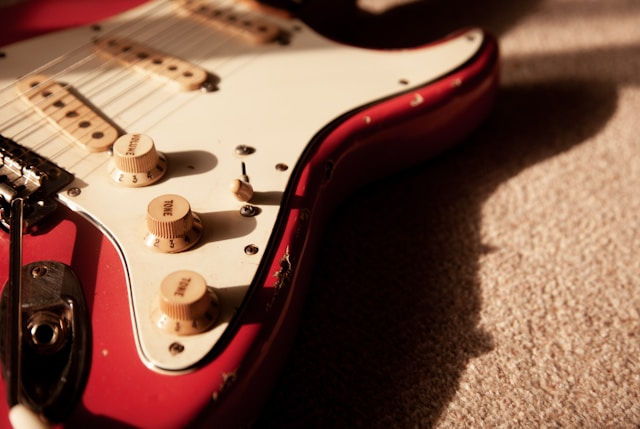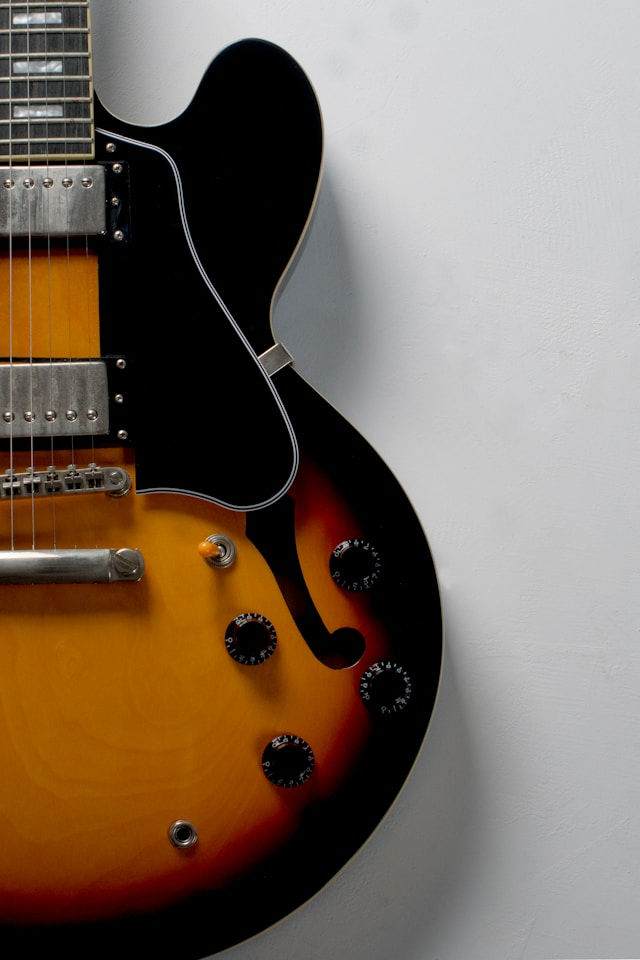Exploring the Iconic: A Deep Dive into the Most Popular Types of Electric Guitars
- The American Guitar Academy
- May 21, 2024
- 7 min read
The electric guitar stands as an emblem of musical innovation, cultural revolution, and sonic exploration. Since its inception in the early 20th century, it has undergone numerous transformations, leading to the creation of various types, each with its own unique characteristics and devoted following. In this essay, we will delve into the most popular types of electric guitars, tracing their evolution, examining their distinctive features, and celebrating their enduring legacy.
1. The Stratocaster: A Symbol of Versatility and Innovation
Developed by Leo Fender in the 1950s, the Fender Stratocaster revolutionized the electric guitar landscape with its sleek design and versatile tonal capabilities. The Stratocaster's double-cutaway body allows for easy access to higher frets, enhancing playability and facilitating expressive performances. One of its defining features is its three single-coil pickups, strategically positioned to offer a wide range of tones. From bright and twangy to warm and mellow, the Stratocaster can effortlessly adapt to various musical styles and playing techniques. Additionally, the inclusion of a tremolo bridge system enables players to manipulate pitch and add subtle nuances to their sound. The list of notable players who have wielded the Stratocaster reads like a who's who of guitar legends, including Jimi Hendrix, Eric Clapton, and Stevie Ray Vaughan. Beyond its iconic design, the Stratocaster's influence extends far beyond the realm of electric guitars, shaping the sound of rock, blues, and pop music for generations to come.

2. The Les Paul: A Timeless Classic with Unparalleled Sustain
Introduced by Gibson in the 1950s and named after the legendary guitarist Les Paul, this guitar quickly became synonymous with rock and roll. The Les Paul's single-cutaway body design features a solid mahogany body with a maple top, delivering rich sustain and resonance prized by guitarists seeking powerful, expressive tones. One of its most significant innovations was the implementation of humbucking pickups, which effectively reduced noise and delivered thick, beefy tones ideal for rock music. Additionally, the Les Paul's set neck construction further enhances sustain and resonance, ensuring that every note sings with clarity and definition. Throughout the decades, the Les Paul has been the instrument of choice for countless guitar heroes, including Jimmy Page, Slash, and Billy Gibbons. Its distinctive sound and timeless design have left an indelible mark on rock music, cementing its status as an enduring icon of musical excellence.
3. The Telecaster: A Pioneer of Electric Guitar Design
Another creation of Leo Fender, the Fender Telecaster, or "Tele," debuted in the 1950s as the world's first commercially successful solid-body electric guitar. Its single-cutaway body features a simple, utilitarian design crafted for maximum reliability and durability. The Telecaster's signature twangy tone is achieved through its two single-coil pickups, which deliver bright, articulate sound with a distinctive bite. The guitar's bolt-on neck construction allows for easy maintenance and adjustment, ensuring optimal playability for performers of all skill levels. Over the years, the Telecaster has found favor with a diverse array of musicians, from country pickers to punk rockers. Notable players such as Keith Richards, Bruce Springsteen, and James Burton have wielded the Telecaster to create timeless music that resonates with audiences around the world. Its straightforward design and distinctive tone make it a perennial favorite among guitarists seeking versatility and reliability in their instruments.

4. The SG: A Lightweight Powerhouse of Rock
Originally introduced as the "Les Paul SG" in the 1960s, the Gibson SG quickly gained popularity for its lightweight design and aggressive tone. The SG's double-cutaway mahogany body features pointed horns, providing improved upper-fret access and a sleek, modern aesthetic. Equipped with dual humbucking pickups, the SG delivers high-output, crunchy tones favored by hard rock and metal guitarists. Its slim, fast-playing neck profile makes it ideal for shredding and soloing, while its resonant construction ensures ample sustain and clarity. From the searing riffs of Angus Young to the heavy blues licks of Derek Trucks, the SG has found its way into the hands of some of the most influential guitarists of the past century. Its distinctive sound and comfortable playability have made it a staple in genres ranging from blues and rock to heavy metal and beyond.
5. The ES-335: Bluesy and Soulful Sounds
The Gibson ES-335 stands as a paragon of versatility and craftsmanship in the realm of electric guitars. Introduced in 1958, the ES-335 was a groundbreaking innovation, combining the rich, warm tones of a hollowbody guitar with the sustain and feedback resistance of a solid-body instrument. Its semi-hollow design features a maple center block running through the body, which not only enhances sustain but also reduces the risk of feedback at high volumes. The ES-335's dual humbucking pickups deliver a broad spectrum of tones, from creamy blues to biting rock and everything in between. Its elegant aesthetics, including F-holes, bound body, and classic finishes, exude vintage charm and sophistication. Over the decades, the ES-335 has been wielded by countless guitarists across genres, from blues legends like B.B. King to rock icons like Eric Clapton and Chuck Berry. Its timeless design and unparalleled sonic versatility have solidified its status as a true icon of the electric guitar world, beloved by players and enthusiasts alike.
6. The Hollowbody: A Vintage Sound with Timeless Elegance
Popularized in the jazz and blues scenes of the 1930s and 1940s, hollowbody electric guitars feature a hollow or semi-hollow body construction, producing warm, resonant tones prized by discerning musicians. These guitars typically feature either single-coil or humbucking pickups, offering a wide range of tonal options to suit various playing styles and musical genres. The inclusion of F-holes or other soundholes enhances projection and adds to the instrument's aesthetic appeal, evoking a sense of vintage elegance and sophistication. Throughout the decades, hollowbody guitars have played a crucial role in shaping the sound of jazz, blues, rockabilly, and beyond. Legends from various genres such as Wes Montgomery, Chuck Berry, and George Harrison have all wielded hollowbody guitars to create timeless music that continues to inspire and captivate audiences to this day.

Other Classic Models
In addition to the iconic electric guitars mentioned earlier, there are several other popular models that have left an indelible mark on the world of music.
Gibson Flying V
One such guitar is the Gibson Flying V, introduced in the late 1950s as part of Gibson's futuristic Modernist Series. Its distinctive V-shaped body, inspired by the burgeoning space age aesthetics of the time, made a bold statement both visually and sonically. Equipped with dual humbucking pickups, the Flying V delivers powerful, high-output tones favored by hard rock and heavy metal guitarists. Its aggressive design and commanding presence on stage have made it a favorite among performers seeking to make a statement with their instrument.
Fender Jazzmaster
Another noteworthy guitar is the Fender Jazzmaster, introduced in 1958 as Fender's top-of-the-line electric guitar model. Originally marketed towards jazz musicians, the Jazzmaster's unique offset waist design and wide range of tonal options quickly caught the attention of players across various genres. Its soapbar pickups, designed to reduce hum and deliver a smooth, articulate sound, offer a departure from the bright, twangy tones associated with Fender's other models. The Jazzmaster's lush, atmospheric sound has found favor with alternative rock, indie, and shoegaze musicians seeking to explore new sonic territories.
Gretsch White Falcon
The Gretsch White Falcon is yet another iconic guitar that has captivated musicians with its striking aesthetics and rich, luxurious tones. Introduced in the late 1950s as Gretsch's flagship model, the White Falcon features a distinctive hollowbody construction, adorned with gold hardware, ornate binding, and a gleaming white finish. Its dual Filter'Tron pickups produce a distinctive, shimmering sound that is both articulate and dynamic, making it a favorite among rockabilly, country, and rock guitarists. The White Falcon's elegant design and sumptuous tone have cemented its status as a true classic in the world of electric guitars.
These are just a few examples of the many popular guitars that have shaped the landscape of modern music. Each model brings its own unique combination of design, tone, and playability to the table, catering to the diverse needs and preferences of musicians around the world. Whether it's the aggressive sound of the Flying V, the smooth tones of the Jazzmaster, or the luxurious elegance of the White Falcon, these guitars continue to inspire and captivate players across generations, ensuring their enduring legacy in the pantheon of musical instruments.
Choosing the Right Instrument for You
Choosing the right electric guitar is a deeply personal and subjective process, influenced by factors such as playing style, musical preferences, budget, and aesthetic preferences. However, there are several key considerations to keep in mind when embarking on the journey to find the perfect instrument.
Genre Matters
First and foremost, it's essential to consider your preferred playing style and the genre(s) of music you intend to play. Different electric guitars are suited to different styles, with each model offering its own unique tonal characteristics and playability. For example, if you're primarily interested in playing blues or classic rock, you might gravitate towards a guitar with single-coil pickups, such as a Fender Stratocaster or Telecaster, known for their bright, twangy tones. On the other hand, if you're into heavier styles like hard rock or metal, you might opt for a guitar with humbucking pickups, such as a Gibson Les Paul or SG, prized for their thick, powerful sound.
Find the Right Price Point
Next, consider your budget and the level of quality you're comfortable with. Electric guitars come in a wide range of price points, from budget-friendly entry-level models to high-end instruments crafted from premium materials and components. While it's tempting to splurge on a top-of-the-line guitar, it's important to remember that there are plenty of excellent options available at more affordable price points. Ultimately, the best guitar for you is one that fits within your budget and provides the features and quality you need to achieve your musical goals.
See For Yourself!
Additionally, it's crucial to try out different guitars in person before making a purchase, if possible. Visiting a local music store and spending some time experimenting with different models will give you a better sense of how each guitar feels and sounds in your hands. Pay attention to factors such as the neck profile, fretboard radius, and overall ergonomics, as these can greatly impact your playing experience. Trust your instincts and choose the guitar that feels comfortable and inspiring to play.
Looks Matter
Lastly, don't overlook the importance of aesthetics when choosing an electric guitar. While it's true that sound and playability should take precedence, there's no denying the emotional connection that comes from owning an instrument that looks and feels great. Whether you prefer the vintage charm of a sunburst finish, the sleek modernity of a solid black guitar, or the flamboyant elegance of a flametop, choose a guitar that speaks to your personal sense of style and identity.
Gotta’ Play Em All
The electric guitar stands as a testament to human creativity, innovation, and the boundless possibilities of artistic expression. From the iconic designs of Leo Fender and Gibson to the timeless elegance of hollowbody guitars, each type has carved out its own niche in the history of music. Whether it's the versatile tones of the Stratocaster, the raw power of the Les Paul, or the vintage charm of the hollowbody, electric guitars continue to inspire and captivate musicians and audiences alike, ensuring their place as enduring symbols of musical excellence.
-Ryan

Comments